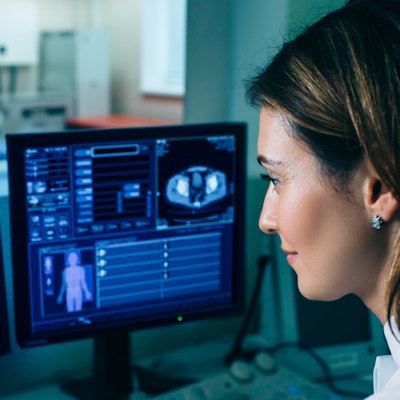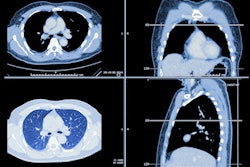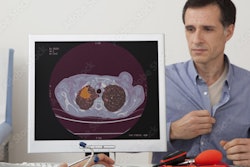
Researchers have found that an artificial intelligence (AI) denoising method can further reduce radiation dose needed for ultralow-dose CT (LDCT) lung cancer screening exams, according to a study published April 4 in Academic Radiology.
The denoising method works without missing actionable pulmonary nodules or life-threatening findings such as aortic aneurysms, a team led by Dr. Larisa Gorenstein of Sheba Medical Center in Tel Hashomer, Israel.
"AI-based denoising [eases] the use of the significant radiation dose reduction, significantly improves] image noise ... [and preserves] the ability to separate patients into those with a negative screening exam to those who require further investigation," the investigators noted.
Lung cancer is the leading cause of cancer death around the world, the group explained, and catching it early improves patient outcomes; low-dose CT screening is now the standard of care for those at higher risk of the disease, but since it involves exposing asymptomatic people to radiation, optimizing this exposure is a key goal.
But reducing radiation exposure tends to lead to more image noise. Gorenstein and colleagues conducted a study that applied the adaptive statistical iterative reconstruction AI algorithm to a set of ultralow-dose CT studies. The study included 119 patients who underwent a low-dose CT scan and an ultralow-dose CT scan; two readers compared images that were processed with the AI algorithm to those that were not.
Overall, the AI algorithm reduced ultralow-dose CT radiation dose by 76% compared with regular LDCT, and there was no statistically significant difference between negative and actionable Lung-RADS categories between the two techniques.
But adding the denoising algorithm improved LDCT performance even more.
| Comparison of ultralow-dose CT to denoised ultralow-dose CT for lung cancer screening | |||
| Measure | Ultra-LDCT | AI denoised ultra-LDCT | Percent difference |
| Standard deviation (the lower the SD, the lower the image noise) | 32.3 HU | 25 HU | -22.3% |
| Signal-to-noise ratio (the higher the ratio, the better the signal quality) | 33.7 | 43.4 | 28.7% |
| Coronary artery calcifications (CACs) identified in patient cohort | 62.2% | 74% | 19% |
The group also found that interreader agreement for assessing CAC was almost perfect: 0.9 for LDCT, 0.9 for denoised ultra-LDCT, and 0.81 for ultra-LDCT.
AI could offer substantial benefits when used with LDCT, according to the team.
"Greater reduction in radiation dose for screening studies is possible, and AI-based denoising techniques are promising," the group concluded. "They should be further evaluated on a much larger scale for screening studies and hopefully will be proven useful for other CT indications as they are a cost-effective method for a significant dose reduction."





















